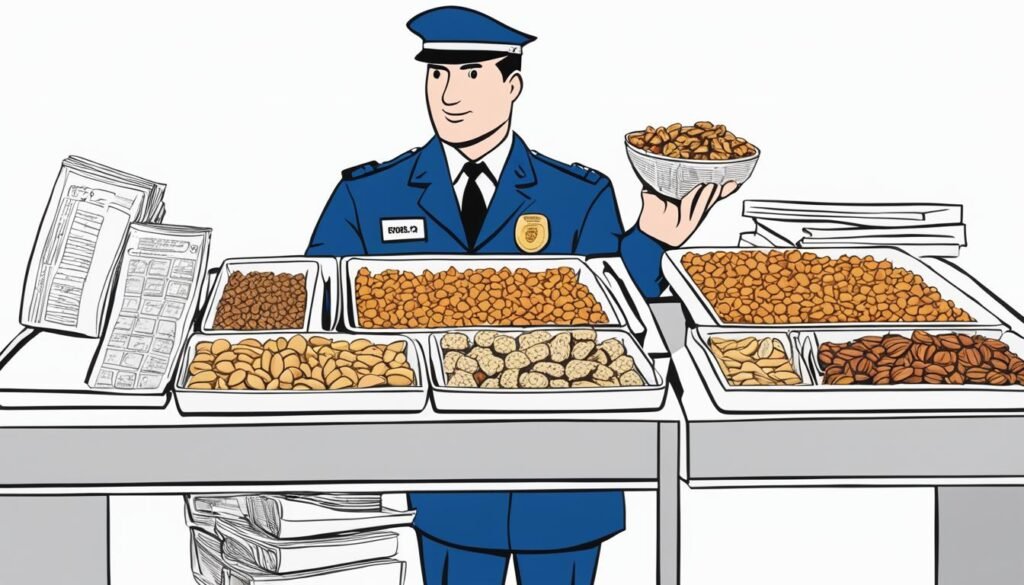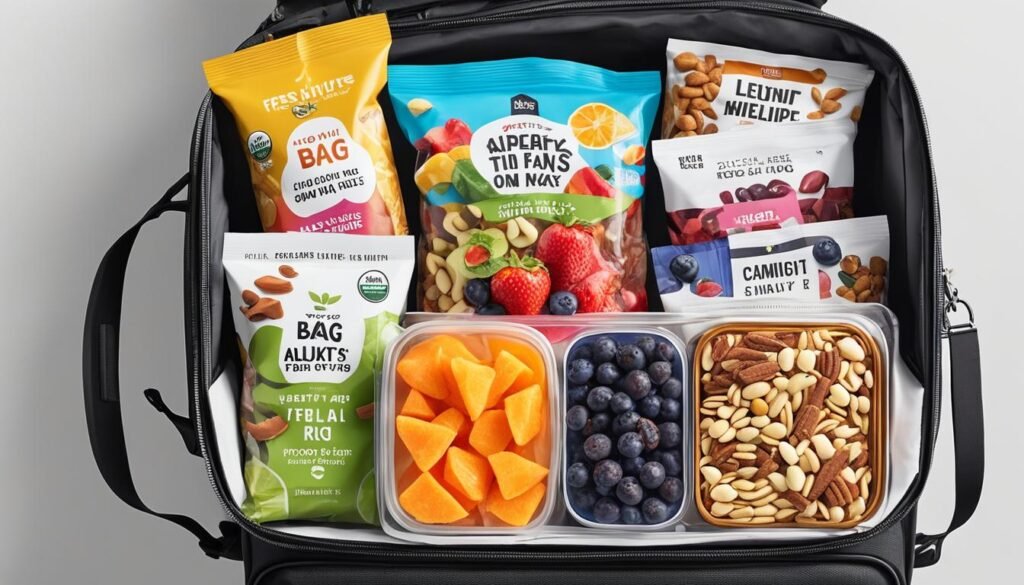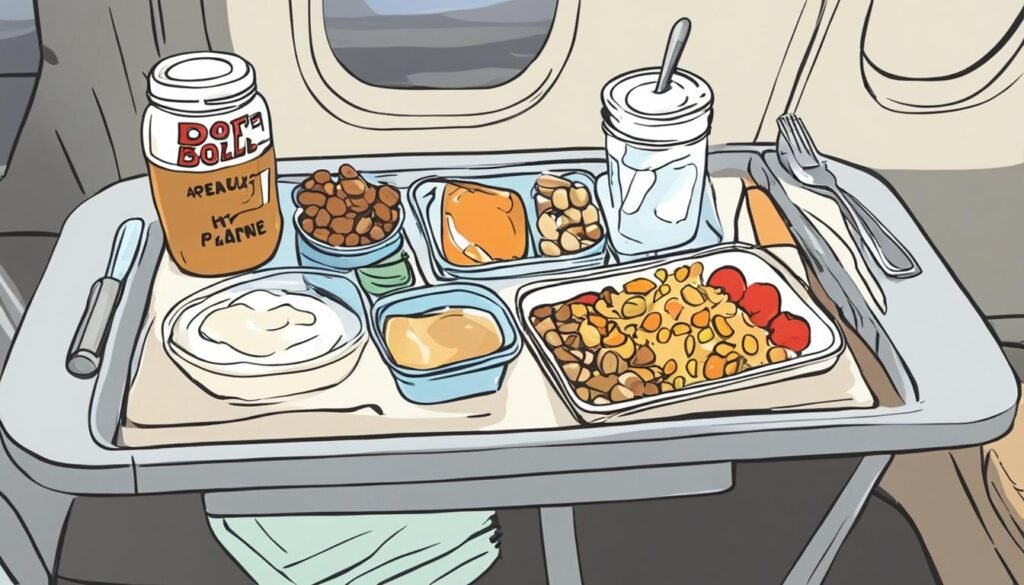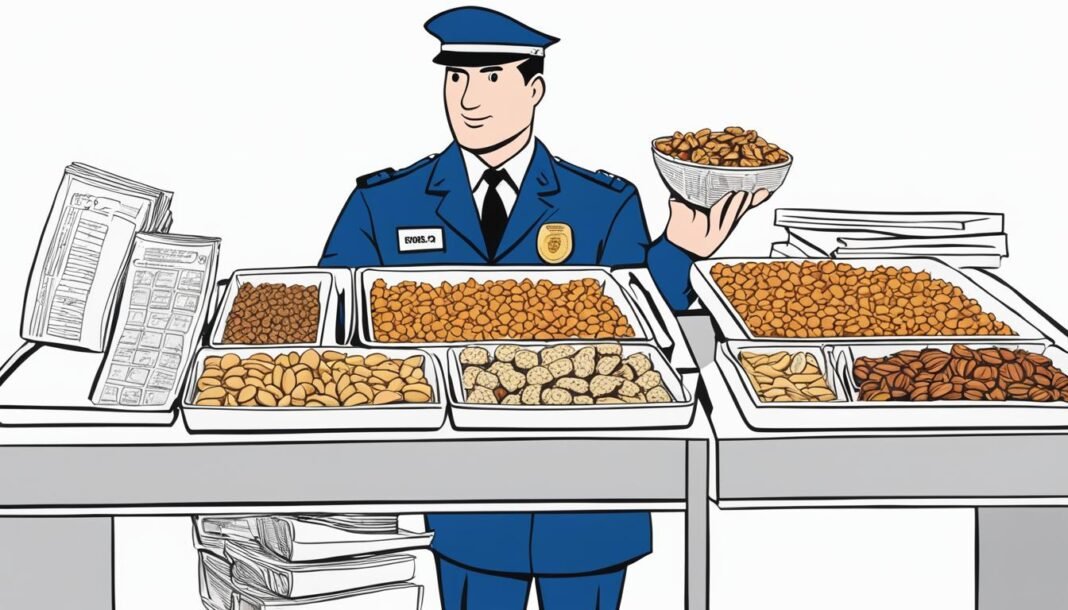Understanding the TSA guidelines and airplane snack regulations can help you pack your favorite treats without any issues.
Let’s explore the permitted snacks on a plane and packing snacks for air travel to ensure a smooth journey.
According to the Transportation Security Administration (TSA), certain snacks are allowed in your carry-on luggage. This includes formula, breast milk, toddler drinks, and baby/toddler food in quantities greater than 3.4 ounces or 100 milliliters.
These items are considered medically necessary liquids and do not need to fit within a quart-sized bag. It is essential to inform the TSA officer at the beginning of the screening process and remove these items from your carry-on bag for separate screening.
Ice packs and other accessories required to cool formula and breast milk are also allowed. Rest assured that TSA X-ray machines do not harm food or medicines, but alternative screening methods are available if desired.
Key Takeaways:
- Formula, breast milk, and baby/toddler food can be brought on a plane in quantities greater than 3.4 ounces or 100 milliliters.
- Inform the TSA officer and separate these items for separate screening.
- Ice packs and accessories to cool formula and breast milk are allowed.
Can You Bring Snacks on a Plane? TSA Rules

When it comes to bringing food on a plane, the TSA has specific rules in place. Understanding these rules can help ensure a seamless travel experience without any hassles at the security checkpoints. Let’s take a look at some important guidelines to keep in mind when packing your snacks for air travel.
3-1-1 Liquids Rule
The TSA’s 3-1-1 liquids rule applies to snacks that are considered a liquid, paste, or gel. According to this rule, these items must be in containers of 3.4 ounces or less. To comply with this regulation, be mindful of the following snacks:
- Juices
- Yogurt
- Syrup
- Soups
- Spreads
- Creamy cheeses
However, it’s important to note that solid foods like sandwiches and pasta are not subject to the 3-1-1 liquids rule. You can enjoy these types of snacks without worrying about the container size.
TSA-Approved Snacks
The TSA provides a helpful “What Can I Bring?” tool on their website, where you can check whether your snacks are allowed. In addition to the guidelines, there are also TSA-approved snacks and meals that you can bring on board. Here are some examples:
- Sliced veggies with hummus
- Protein bars
- Dried fruits and nuts
- Sandwiches
These pre-packaged snacks are a convenient and hassle-free option for your journey.
To make it easier for you to understand the TSA food rules, here’s a summarized table:
| Food | TSA Guidelines |
|---|---|
| Liquids, Pastes, and Gels | Containers must be 3.4 ounces or less |
| Sandwiches and Pasta | Not subject to 3-1-1 liquids rule |
| Juices, Yogurt, Syrup, Soups, Spreads, Creamy Cheeses | Must comply with 3-1-1 liquids rule |
| Sliced Veggies with Hummus, Protein Bars, Dried Fruits and Nuts, Sandwiches | TSA-approved snacks and meals |
Remember to pack your snacks in an organized manner, separating them from other belongings. This will make it easier for security officers to screen your items quickly and efficiently.
By following these TSA food rules, you can enjoy your favorite snacks during your flight, ensuring a comfortable and satisfying travel experience.
Special Rules for Baby Food, Breast Milk, and Formula

Parents traveling with infants or toddlers can bring baby food, breast milk, and formula on a plane. These items are allowed in reasonable quantities and must be separated from other belongings for screening. TSA officers may need to test the liquids for explosives or concealed prohibited items.
It is important to note that a child does not need to be present or traveling with the parent to bring breast milk, formula, and related supplies. Additional screening procedures, such as advanced imaging technology and pat-downs, may be required.
If you are traveling with baby food, breast milk, or formula, it is important to be aware of the TSA rules and procedures. These rules are in place to ensure the safety of all passengers while still accommodating the needs of parents and caregivers.
When passing through the security checkpoint, separate the baby food, breast milk, and formula from the rest of your belongings. You may be asked to remove these items from your carry-on bag for separate screening. It is helpful to inform the TSA officer at the beginning of the screening process that you have baby food, breast milk, or formula in your possession.
TSA officers may need to test the liquids for explosives or concealed prohibited items. They may ask you to open containers or provide additional information about the items. It is important to cooperate with the TSA officers and follow their instructions for the screening process.
It is also worth noting that a child does not need to be present or traveling with the parent to bring breast milk, formula, and related supplies. This allows parents who are pumping or storing breast milk to bring it on the plane even if their child is not with them.
Additional screening procedures, such as advanced imaging technology and pat-downs, may be required. This is to ensure the safety and security of all passengers. If you have any concerns or questions about the screening process, don’t hesitate to ask the TSA officers for assistance.
Traveling with baby food, breast milk, or formula can be a stressful experience, but knowing the TSA rules and screening procedures can help make the process smoother. By following the guidelines and cooperating with the TSA officers, you can ensure that your baby’s food and supplies are safely screened and allowed on the plane.
| Item | Allowed Quantity |
|---|---|
| Baby Food | Reasonable quantities |
| Breast Milk | Reasonable quantities |
| Formula | Reasonable quantities |
Alcohol and Frozen Food on a Plane
Traveling by plane comes with certain restrictions when it comes to bringing alcohol and frozen food onboard. Understanding the TSA regulations for alcohol and guidelines for frozen food can help ensure a smooth and hassle-free travel experience.
Bringing Alcohol on a Plane
Mini bottles of alcohol are allowed in carry-on bags, as long as they do not exceed 70% alcohol content. However, it’s important to note that consuming alcohol that is not served by a flight attendant is not permitted. If you wish to enjoy an alcoholic beverage during your flight, make sure to request it from the cabin crew.
Bringing Frozen Food on a Plane
Bringing frozen food on a plane is permitted, both in carry-on and checked bags. However, there are certain guidelines to follow. Frozen food must be completely frozen solid at the time of screening. Partially melted or thawed frozen items will not be allowed through security. It’s crucial to ensure your frozen food remains in a frozen state to meet the TSA guidelines.
Additional Considerations
While the TSA provides general guidelines for alcohol and frozen food, it’s essential to check with your specific airline and destination for any additional rules or restrictions. Some airlines may have specific regulations or limitations on the type or quantity of alcohol that can be brought onboard. Certain destinations may also have their own guidelines regarding the importation of alcoholic beverages or frozen food. It’s always best to be well-informed before your journey to avoid any issues or inconveniences.
Food Prohibited by the TSA

The Transportation Security Administration (TSA) does not technically prohibit any specific food items. However, there are restrictions on the quantities of liquids, pastes, and gels that can be brought on a plane. It is important to ensure that these items are in containers of 3.4 ounces or less and properly packaged.
Canned food is generally not recommended to be brought in carry-on bags as it may raise security concerns. Fresh fruits and vegetables are allowed, except when traveling from certain locations with restrictions.
| Item | Status |
|---|---|
| Liquids (e.g., soup, sauce) | Restricted to containers of 3.4 ounces or less |
| Pastes (e.g., peanut butter, jelly) | Restricted to containers of 3.4 ounces or less |
| Gels (e.g., yogurt, jelly) | Restricted to containers of 3.4 ounces or less |
| Canned food | Not recommended in carry-on bags |
| Fresh fruits and vegetables | Allowed, except when traveling from certain locations |
While there may not be specific food items prohibited by the TSA, it is essential to adhere to the rules and regulations regarding the quantities and packaging of liquids, pastes, and gels. By following these guidelines, passengers can ensure a smooth and hassle-free screening process at the airport.
Tips for Packing Snacks for Air Travel
When preparing snacks for your air travel, it’s essential to adhere to the Transportation Security Administration (TSA) guidelines. To ensure compliance with the 3-1-1 liquids rule, consider using TSA-approved containers like reusable silicone bags or snack cups. These containers provide a convenient way to pack your snacks while keeping them within the allowed limits.
It is advisable to pack your snacks separately from other belongings in order to facilitate the security screening process. Utilize lunch bags or containers to preserve the freshness of perishable items during your journey. However, be mindful not to pack easily perishable or strongly scented foods, as a courtesy to your fellow passengers.
By following these tips, you can streamline the process of packing snacks for air travel, making it more convenient for both yourself and the TSA. Remember to prioritize TSA-approved containers, separate your snacks, and choose non-perishable options to ensure a hassle-free travel experience.
Continue Reading:
- Can You Bring Food on a Plane? TSA Guidelines
- Can You Bring SARMS on a Plane?
- Can You Bring Safety Pins on a Plane in 2024?
- Can You Bring Rocks on a Plane in 2024?
- Can You Bring Pepper Spray on a Plane in 2024?
- Can You Bring Nips on a Plane in 2024?
- Can You Bring Nicotine Gum on a Plane?
- Can You Bring Matches on a Plane? TSA Rules 2024
- Can You Bring Ice on a Plane?
- Can You Bring Handcuffs on a Plane?
Frequently Asked Questions
Can I bring snacks on a plane?
Yes, you can bring snacks on a plane. However, there are guidelines set by the Transportation Security Administration (TSA) that determine what types of snacks are allowed and any restrictions that may apply.
What are the TSA guidelines for bringing snacks on a flight?
The TSA allows solid food items such as sandwiches and pasta to be brought on a plane. However, snacks that are considered liquids, pastes, or gels must adhere to the 3-1-1 liquids rule, meaning they must be in containers of 3.4 ounces or less. You can use the TSA’s “What Can I Bring?” tool for more specific information on which snacks are allowed.
Are there specific regulations for bringing baby food, breast milk, and formula on a plane?
Yes, parents traveling with infants or toddlers can bring baby food, breast milk, and formula on a plane. These items are allowed in reasonable quantities and must be separated from other belongings for screening. Additional screening procedures may be required, such as testing the liquids for explosives or concealed prohibited items. The child does not need to be present or traveling with the parent to bring these items.
Can I bring alcohol on a plane?
Mini bottles of alcohol are allowed in carry-on bags as long as they do not exceed 70% alcohol. However, drinking alcohol that is not served by a flight attendant is not permitted. It is important to check with airlines and specific destinations for any additional rules regarding alcohol on a plane.
Can I bring frozen food on a plane?
Frozen food is allowed in both carry-on and checked bags as long as it is frozen solid at the time of screening. Partially melted frozen items will not be allowed. It is important to check with airlines and specific destinations for any additional rules regarding frozen food on a plane.
Are there any specific food items that are prohibited by the TSA?
The TSA does not technically prohibit any specific food items. However, there are restrictions on the quantities of liquids, pastes, and gels that can be brought on a plane. It is important to ensure that these items are in containers of 3.4 ounces or less and properly packaged. Canned food is generally not recommended to be brought in carry-on bags as it may raise security concerns. Fresh fruits and vegetables are allowed, except when traveling from certain locations with restrictions.
How should I pack snacks for air travel?
When packing snacks for air travel, it is recommended to use TSA-approved containers, such as reusable silicone bags or snack cups, to ensure snacks meet the 3-1-1 liquids rule. It is also best to pack snacks separately from other belongings and use lunch bags or containers to keep perishable items fresh. Avoid packing easily perishable or strongly scented foods to consider your fellow passengers.


